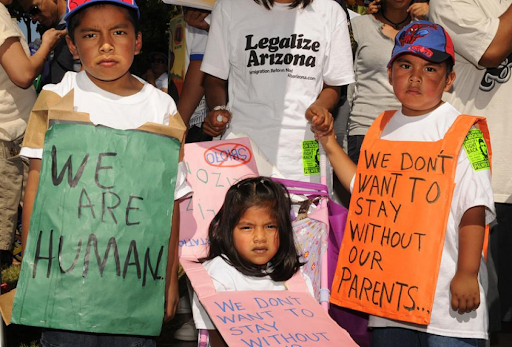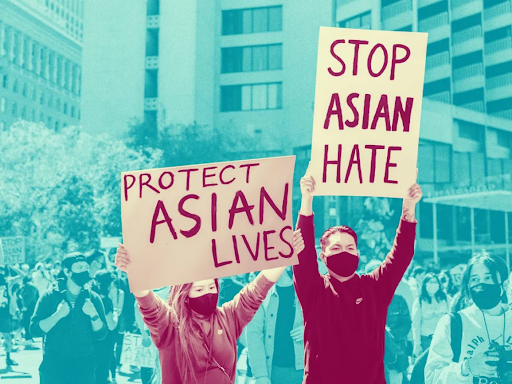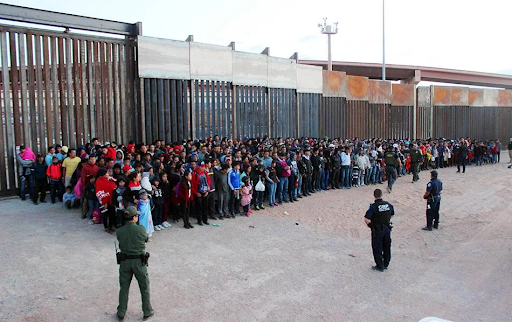Immigrant children detained in cages — inhumane treatment at the border (Long 2019).
By: Julia Li
The first years of school lay a foundation for how a child becomes a student, and how they view themselves in relation to the broader community. It’s an impressionable period toward the fullest realization of who they are.
Yet, for other children— it’s different. Many young children of immigrants — who account for around a quarter of all children under age eight in the US — face discrimination at school during this formative period (Carnock 2015).
Discrimination at an early stage disrupts a child’s understanding of how they fit into their family, culture, and community. Hesitant with their identity, a multitude of negative psychological, academic, and social outcomes can transpire.
But that’s not all.
As The United Nations on the Convention of the Rights of the Child states, we need to protect children against “all forms of discrimination or punishment on the basis of the status, activities, expressed opinions, or beliefs of the child's parents, legal guardians, or family members.” (OHCHR 1990).
A Classroom for Learning — A Direct Strike of Discrimination
In a classroom, children learn about themselves— their strengths, weaknesses and prepare for a brighter future. For every student, teachers are their role models, offering guidance and dedication to learning.
However, these teachers may also introduce discrimination to immigrant children.
In a report published by the Migration Policy Institute, The Impact of Discrimination on the Early Schooling Experiences of Children from Immigrant Families, researcher Jennifer Keys Adair shares that immigrant children face discrimination from staff and peers at school. These may be critical comments about a student’s accent, appearance, or use of native language. Teachers may also have impatient reactions when students cannot fully express themselves (Carnock 2015).
Furthermore, many teachers limit these children from opportunities for creativity, inquiry, and problem-solving. Academic expectations are lowered for these children, instead, directing them to rote, monotonous tasks.
Other examples include insufficient preparation for working with children of immigrants, low recruitment of culturally aware and bilingual educators, and weak teacher connections to immigrant families.
These negative interactions are preventing children of immigrants to have a safe, stress-free environment to thrive.

A classroom of questions, answers, and possibly discrimination (Penn Today 2019).
Schools: Infected with Structural Discrimination
At this level, discrimination against children of immigrants becomes a highly alarming issue. These children are discriminated against from racial and socioeconomic segregation of schools, lack of access to high-quality teachers and resources, low levels of parental engagement, and disproportionate emplacement in special education (Carnock 2015).
From Education to Job: An Unpredictable Route
Education, beyond doubt, has advanced growth in our society, creating new jobs and technological innovations — giving children an opportunity to change the future.
But with a low level of education, immigrant children are stuck in low-paid jobs with poor working conditions. A study done by OECD, Indicators of Immigrant Integration 2015, showed that youth with immigrant parents experienced 50% more unemployment in the European Union than those with native-born parents (OECD 2015).
Overall, however, education outcomes are improving for many immigrant children, but major gaps remain, especially for immigrant children with low-educated parents. With a socio-economically disadvantaged background, the number of immigrant students in the European Union who perform at the highest levels in the OECD’S PISA literacy tests is only half that of native-born students (OECD 2015).
As these factors weigh, our answer still lies in education — a tool that guarantees development for future immigration integration.
Laws Violating Rights
Since July 2017, US immigration authorities have violated international human rights laws and humanitarianism. They have forcibly separated more than 5400 children from their parents who are refugees or illegal immigrants in the southern border area (Embassy of The People's Republic of China in The Republic of Fiji 2020).
These immigrant families suffered insulting treatment with the government violating their human rights. Many children died in custody, forever tearing apart a family.
In April 2018, the US government implemented a “zero-tolerance” immigration policy which allowed law-enforcement officers at the border to arrest refugees and illegal immigrants. This caused at least 2000 children to be separated from their families (Embassy of The People's Republic of China in The Republic of Fiji 2020).
Two months later, in June 2018, the UN Independent Expert on human rights and international solidarity submitted a report conforming with the UN Human Rights Council’s 35/3 resolution. The report asserted that the US government’s act of forcibly separating children from their asylum-seeking parents severely harmed the immigrants’ right to life, dignity, freedom, and other human rights (Embassy of The People's Republic of China in The Republic of Fiji 2020).

Immigrant Children Protesting for their Human Rights (Gross 2015).
Other than violation of human rights, immigrant children also faced cruel, inhumane, and degrading treatment, with their right to health also being severely violated. For instance, inspection teams evaluating border shelters found that migrant children were in a prison-like environment, with more than 300 children detained in a cell without adult supervision. From overcrowding and poor sanitation, since 2018, seven children have died (Embassy of The People's Republic of China in The Republic of Fiji 2020). Moreover, from these poor conditions in border shelters, hundreds of immigrants have tested positive for COVID-19, migrant children included.
There have been a dramatically increased number of cases in which US border law-enforcement officers have abused migrant children in these shelters. One hundred sixteen cases were disclosed, with officers being accused of physical, sexual, or psychological abuse of children aged 5 to 17 (Embassy of The People's Republic of China in The Republic of Fiji 2020).
But there is still hope for change. In the United States and the international community, the US government’s policies that violated immigrant children’s rights have been strongly criticized.
COVID-19
COVID-19 has a mass global impact, specifically on immigrants and their children. As more jobs close, immigrants are experiencing a severe loss of income, leading to insecurity. These strains increase the risk of violence and family stress inflicted on the child. For children, this increased isolation and reduced mobility from the pandemic have increased the risk of abuse, exploitation, and trafficking.
For migrant children, schools provide a sense of belonging, a source of food, an opportunity to identify abuse, and a chance to socialize. But amidst the COVID-19 pandemic, school closures have eliminated this haven of safety, disrupting child protection services, to which migrant children already have limited access. In addition, immigrant children may also face issues with online learning platforms.
Before the pandemic, there has been severe discrimination against immigrant youth already, and it has only worsened. According to ASEAN, reports show that there has been increased verbal abuse against certain nationalities and immigrants that supposedly “brought” the virus to communities (Douglas et al. 2020). This discrimination puts migrant children at risk of both gender-based and xenophobic violence, harassment, and trafficking.

Discrimination against immigrants from China. #StopAsianHate (Kumar 2021).
Even worse, in the United States, immigrant detention centers were one of the most severely affected places in the country. Why?
The US government completely ignored the risk of virus transmission. According to the United Nations in a report published on May 21, 2020, since March, the US government has sent more than 1000 unaccompanied immigrant children to Central and South America back to their country. UNICEF disagreed with this move, as it would expose the children to greater danger (Embassy of The People's Republic of China in The Republic of Fiji 2020).
Through this COVID-19 pandemic, we’ve seen an alarming need for immediate responses and long-term recovery measures to address the needs and challenges of immigrant youth. Societies have a shared responsibility to successfully end this pandemic — and no one should be left behind.
Effects of Discrimination against Immigrant Children
Researchers see that there are associations between discrimination and perceived racism and mental health, socio-emotional development, and behavioural outcomes found in the child.
Racial discrimination experienced by parents appears to influence the child’s health directly or indirectly as a result of family stress, or by parents becoming less able to provide a caring environment for their children.
The New Canadian Child and Youth Study has examined the long-term influence of parent’s racism experiences. They concluded that when parents perceived high levels of cultural discrimination, the negative influence on the child’s health became substantial (Anne George and Bassani 2018).
The UK Millennium Cohort Study focused on mothers from five ethnic backgrounds in the USA and found a relationship between the experiences of maternal and family discrimination and children’s socioemotional development at age 11 years (Anne George and Bassani 2018). This mainly occurred because of the mother’s worsening mental health and was related to increased harsh parenting practices.
A study published on Jama Network showed that immigrant youth are at high risk of experiencing discrimination, harassment, aggression, physical violence, and sexual violence (Adhia et al. 2020).
Yet in 2012, the Canadian federal government limited access to health care for refugees and refugee claimants in Canada (Adhia et al. 2020). Hence a higher proportion of immigrant youth is excluded from healthcare.
To solve these issues, youth and families affected by violence should inform research centers. When reported, these effects discrimination has on immigrant children could gain critical insights into prevention and intervention efforts to protect the safety and security of immigrant youth.
Works Cited
Adhia, Avanti, et al. “Violence Against Immigrant Youth in Canada Why More Research Is Needed.” Jama Network, 4 March 2020, https://jamanetwork.com/journals/jamanetworkopen/fullarticle/2761988. Accessed 6 August 2021.
Anne George, M., and Cherylynn Bassani. “Influence of Perceived Racial Discrimination on the Health of Immigrant Children in Canada.” SpringerLink, 24 February 2018, https://link.springer.com/article/10.1007/s12134-018-0539-3. Accessed 6 August 2021.
Carnock, Janie Tankard. “How Young Children of Immigrants Face Discrimination At School.” New America, 18 September 2015, https://www.newamerica.org/education-policy/edcentral/early-discrimination/. Accessed 5 August 2021.
Douglas, Jeremy, et al. “End stigma and discrimination against migrant workers and their children during COVID-19 pandemic.” reliefweb, 9 June 2020, https://reliefweb.int/report/world/end-stigma-and-discrimination-against-migrant-workers-and-their-children-during-covid. Accessed 7 August 2021.
Embassy of The People's Republic of China in The Republic of Fiji. “Serious Discrimination Against and Cruel Treatment of Immigrants Fully Expose Hypocrisy of 'US-Style Human Rights.'” Embassy of The People's Republic of China in The Republic of Fiji, 20 July 2020, http://fj.china-embassy.org/eng/gdxw/t1798982.htm. Accessed 6 August 2021.
Gross, Natalie. “Study: Children of Immigrants Experience Discrimination in Schools Early On.” Education Writers Association, 11 September 2015, https://www.ewa.org/blog-latino-ed-beat/study-children-immigrants-experience-discrimination-schools-early. Accessed 11 August 2021.
Long, Clara. “Written Testimony: "Kids in Cages: Inhumane Treatment at the Border."” Human Rights Watch, 11 July 2019, https://www.hrw.org/news/2019/07/11/written-testimony-kids-cages-inhumane-treatment-border. Accessed 6 August 2021.
OECD. “Discrimination and poor job prospects hit children of immigrants.” OECD, 7 February 2015, https://www.oecd.org/migration/discrimination-and-poor-job-prospects-hit-children-of-immigrants.htm. Accessed 4 August 2021.
OHCHR. “Convention on the Rights of the Child.” OHCHR, 2 September 1990, https://www.ohchr.org/en/professionalinterest/pages/crc.aspx. Accessed 9 August 2021.
Penn Today Staff. “Understanding why teachers discriminate against minority students.” Penn Today, 29 August 2019, https://penntoday.upenn.edu/news/understanding-why-teachers-discriminate-against-minority-students. Accessed 11 August 2021.

